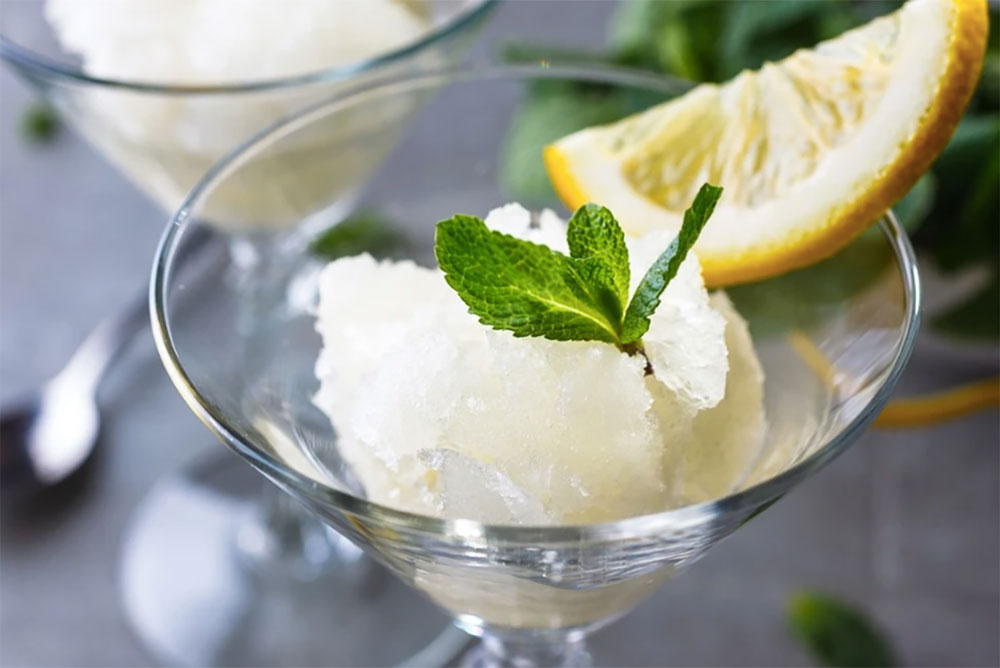
Such a temptation, easily succumbed to (if you have an ice cream maker). Recipe and photo from the Agrodolce.it website.
By Nancy Pollard
 After owning one of the best cooking stores in the US for 47 years—La Cuisine: the Cook’s Resource, in Alexandria, Virginia—Nancy Pollard writes Kitchen Detail, a blog about food in all its aspects—recipes, film, books, travel, superior sources and food-related issues.
After owning one of the best cooking stores in the US for 47 years—La Cuisine: the Cook’s Resource, in Alexandria, Virginia—Nancy Pollard writes Kitchen Detail, a blog about food in all its aspects—recipes, film, books, travel, superior sources and food-related issues.
ONE OF MY favorite singers to listen to while I am cooking is Paolo Conte. I get all the pleasure of his seductive lounge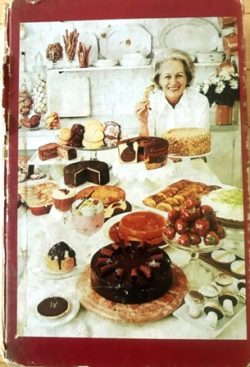 -lizard voice without having to inhale cigarette smoke. My best-loved Conte song has long been Gelato Al Limon’, especially in this, the season for Gelato al Limone and also Sorbetto al Limone. In one of the earliest Kitchen Detail posts, I shared a lovely recipe from Maida Heatter’s first book for a lemon ice cream that you just mix in a bowl and leave in the freezer, taking it out a few times to remix. The reaction between the dairy and the lemon juice creates an effortless ice cream. That recipe was one written by Jean Hewitt, who ran the test kitchens under Craig Claiborne for the New York Times and later became the Food Editor for Family Circle Magazine. She also wrote several cookbooks and was a believer in meals with natural foods at a time when the US was in the thrall of everything canned, instant or frozen.
-lizard voice without having to inhale cigarette smoke. My best-loved Conte song has long been Gelato Al Limon’, especially in this, the season for Gelato al Limone and also Sorbetto al Limone. In one of the earliest Kitchen Detail posts, I shared a lovely recipe from Maida Heatter’s first book for a lemon ice cream that you just mix in a bowl and leave in the freezer, taking it out a few times to remix. The reaction between the dairy and the lemon juice creates an effortless ice cream. That recipe was one written by Jean Hewitt, who ran the test kitchens under Craig Claiborne for the New York Times and later became the Food Editor for Family Circle Magazine. She also wrote several cookbooks and was a believer in meals with natural foods at a time when the US was in the thrall of everything canned, instant or frozen.
Of Knitting and Sorbets
Sorbets should be easy too, but according to the Italian food website Agrodolce, a true Italian sorbetto is a bit like the basis for sweaters, knitting 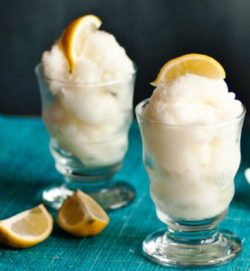 and purling: The steps are simple but without the requisite attention to the method, you end up with a less than satisfactory result. Having made many sorbets and granitas, especially when summer is at its damnedest, I have tried to refine my knitting and purling so that my frozen mix of fruit, sugar, and water was as creamy and lush in flavor as the ones I ate in Italy.
and purling: The steps are simple but without the requisite attention to the method, you end up with a less than satisfactory result. Having made many sorbets and granitas, especially when summer is at its damnedest, I have tried to refine my knitting and purling so that my frozen mix of fruit, sugar, and water was as creamy and lush in flavor as the ones I ate in Italy.
In my early enthusiasm, I used a Baumé hydrometer to measure the sugar density of the syrup—and the density required for sorbets varies depending on the acidity of the fruit, from 25 to 32 Brix. But then, in typical Nancy fashion, I broke my hydrometer and accidentally on purpose never replaced it. I happily switched to making granitas instead and tried the milk-based sherbets but decided that I didn’t like them as much as sorbets.
Once, when my three-week stay in Bologna serendipitously ended in a three-month extension, I ate a lot of different gelati and sorbetti, as well as sandwiches from the mortadella-enthusiast site Mortadella Lab. Cold weather does not lessen my appetite for either.
Of Rules and Rewards
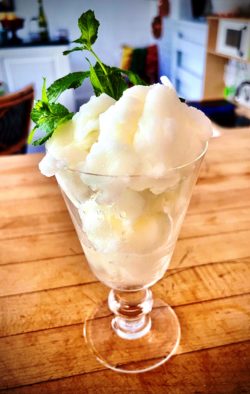 Agrodolce gives us really good rules and a procedure for a truly creamy and not overly sweet (you want sweet plus pucker) Sorbetto al Limone. This formula is not a one-size-fits-all-fruit, so the ratios will be a bit different for strawberries, for example. It does work for limes as well as the yellow guys. You can zest the lemons or limes and freeze the little shreds for other uses in cooking—this appeals to my ever-present waste-not-want-not syndrome.
Agrodolce gives us really good rules and a procedure for a truly creamy and not overly sweet (you want sweet plus pucker) Sorbetto al Limone. This formula is not a one-size-fits-all-fruit, so the ratios will be a bit different for strawberries, for example. It does work for limes as well as the yellow guys. You can zest the lemons or limes and freeze the little shreds for other uses in cooking—this appeals to my ever-present waste-not-want-not syndrome.
No. 1 Rule: You need to use an ice cream maker. You cannot achieve the churned creaminess without it. What you would have instead is a variation of a lemon granita with smaller crystals, which harden in American freezers.
No. 2 Rule: Pick the best fruit. This is not the time to utilize your forgotten wizened lemons or limes. Smell the fruits for aroma. Your best choice will usually be organic lemons or limes. Sometimes I have used Meyer lemons (a delightful marriage of a lemon and a mandarin orange).
No. 3 Rule: Know your sugars and your water. Unless your tap water is extraordinarily delicious, use filtered or bottled water. Dextrose will make the icy granules teeny tiny, and will keep the sorbet from freezing too hard. I normally use caster sugar (my go-to brand is India Tree) as the syrup is clearer the finer sugar than when I make it with regular white granulated sugar.
No. 4 Rule: Follow the ratios in the recipe. This is not the time to be vague about weights and measures.
An extra reward is that the recipe makes an ethereal Sgroppino, an Italian cocktail. Pour about ½ cup Prosecco in a flute, add a tablespoon of vodka and a scoop of this sorbetto. Garnish with a sprig of mint or verbena and serve.
The Perfect Lemon Sorbet
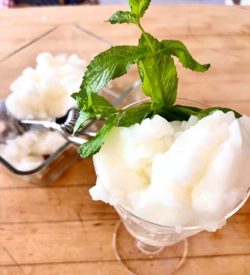
- 450gr (15¾ ounces) water
- 160gr (5-2/3 ounces) caster sugar (you can use granulated white sugar, but caster sugar is easier to make into a syrup)
- 100gr (3½ ounces) glucose or dextrose
- 6- to 8 fresh organic lemons. You need 240 grams (8½ ounces) of juice (it can be 120 grams of lime and 120 grams of lemon, for example)
- Put a saucepan on a scale, and press the tare button to get to zero, then add the water, and tare, the sugar, then tare and then the glucose or dextrose.
- Place the saucepan on a burner over medium heat, stir and allow the syrup to come to the boiling point and then remove from the heat. Refrigerate the syrup.
- Separately, squeeze the lemon or lime juice (or a combination of both).
- Strain it if necessary and refrigerate. (You may want to strain the syrup if you have used granulated sugar.)
- When juice and syrup are very cold, combine them in your ice cream maker.
- Freeze in the ice cream maker for 30 to 40 minutes. (My machine takes about 30 minutes.)
- While the mixture is in the ice cream maker, place your designated storage container in the freezer so it will maintain the sorbet’s texture and temperature.
- This sorbet will reflect the quality of the fruit you purchase and it will be almost white, not yellow (a tint that usually comes from adding a colorant).
- It is unbelievably creamy and unctuous even though it is just those three ingredients.
- Agrodolce suggests that you can use a fine single-flower honey (acacia is their suggestion) as a substitute for the glucose or dextrose.

my three-week stay in Bologna serendipitously ended in a three-month extension
ooooooooo how does that happen??
Thank you for this — a new crooner to accompany my cooking, a delicious recipe, and great explaining of the this and that. Do I still have my ice cream maker….off to the cellar to check.